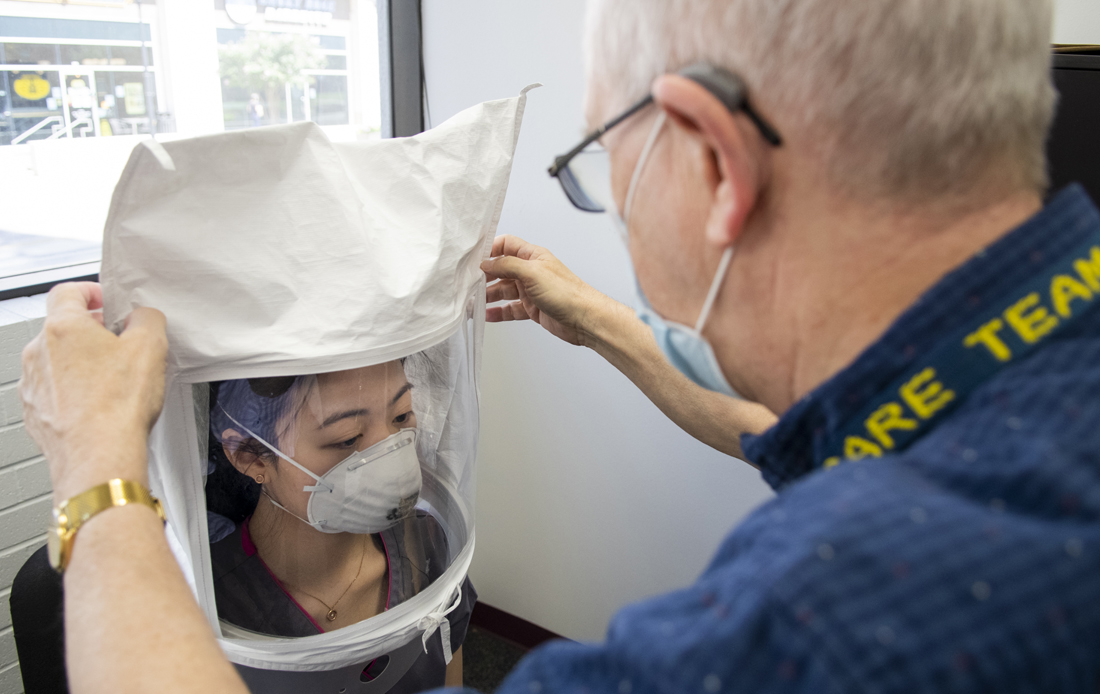One size doesn’t fit all

Masking up for dental patient appointments is a lot more complicated these days. With undetectable COVID-19 germs floating around, there’s no margin for error.
Perfectly fitting hundreds of students, faculty and staff with N95 respirators has taken a small group of experts at Texas A&M College of Dentistry months to accomplish. Each mask fitting takes at least 10 to 15 minutes.
“The hard part initially was that we were in the middle of the summer semester, and there were still quite a few students living out of state or out of town. You can’t virtually fit test someone,” says Dr. Jennifer Barrington, clinical director and clinical associate professor in comprehensive dentistry.
Initially, Texas A&M University sent an additional person from College Station to assist with the fittings. Now Hiram Patterson, environmental health and safety coordinator at the college, works with two certified testers onsite to oversee the process. Greg Washington, also an environmental health and safety coordinator, is the program manager. They’ve been methodically working through the long list of recipients, seeing to it that everyone’s N95 respirator fits properly.
“They are true respirators, which is why we have to conduct fit testing that is required by OSHA and other agencies,” Patterson says.
Once all students returned in early August, the pace picked up, but not without its headaches. Some fittings have been a failure, as in the mask is too large and it leaks. But there’s a solution.
“We just received respirators that come in small sizes to fit test the people who failed to pass the first time,” Patterson says.
Determining if the mask leaks requires a long series of tests. Fitting experts start by asking the subject to adjust their N95 respirator, making sure they have “a good seal, particularly across the bridge of the nose,” he says.

They then remove their N95 respirator so a plastic hood or tent can be placed over their head and rest on their shoulders. At this point, a bitter solution is squeezed into the plastic tent as many as 30 times using a gray nebulizer bulb. If the subject still can’t taste anything, a sweet solution is then sprayed inside. Usually 10 squirts of either solution is enough.
“We tell the person being tested to let us know at any time if they can taste the vapor,” he says. “If they can taste the vapor on their tongue or the back of their throat, then they fail the fit test.”
Assuming the subject passes the first step, the actual fitting can proceed. The subject drinks water to clear their palate and puts their N95 respirator back on. A series of seven exercises, each lasting about a minute, includes administering the actual fit testing solution at the beginning of each exercise and then again 30 seconds into each step, Patterson says. This includes normal breathing, deep breathing, turning their head both ways, bowing their head, counting out loud to 100, walking around the room, sitting back down and then taking normal breaths.
The fitting experts’ job is never fully over, not even after every person on the list has a proper fit. That’s because if the N95’s specific model number changes, “everyone has to go back through the fit testing for the new model number. On top of that, fit testing for whatever model is currently being used has to be redone annually,” Barrington says.